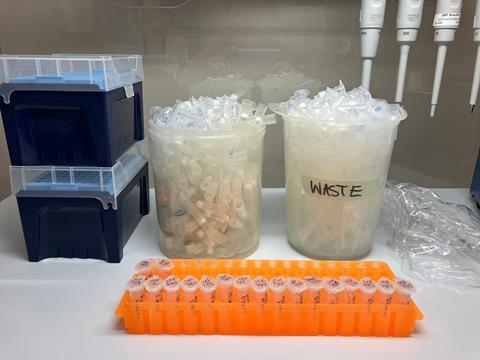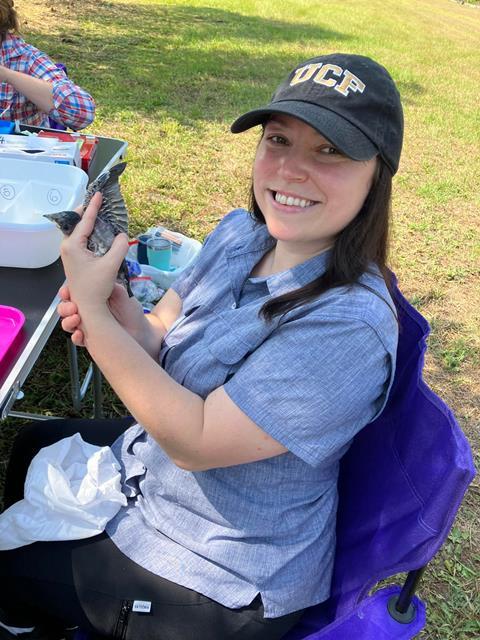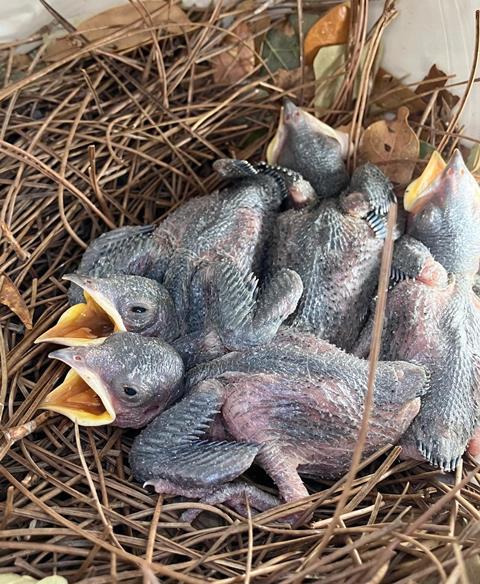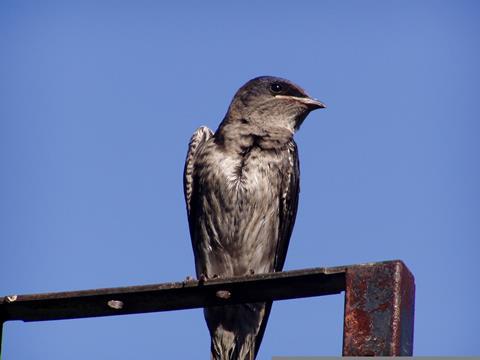Eighteen samples – they were all that remained of the purple martin feces from which I was extracting DNA. During this final celebratory extraction, I was surrounded by beakers overflowing with single-use pipette tips and an ethereal cloud of plastic wrap from pipette boxes. It reminded me of the board game KerPlunk. The tips were stacked and pointed in every possible direction, preventing the tubes from falling to the bottom. Occasionally a tube would slip through, like a marble, eventually filling every nook and cranny of the beaker.
Since I started my research with purple martins, the largest species in the swallow family, at the University of Central Florida (UCF) — first as an undergraduate and now as a Master’s student — I have been in awe of the amount of plastic waste I have generated along the way. Whether it’s vials to collect chick feces or materials for extracting and sequencing DNA, small, plastic disposable items are ubiquitous. It’s a hidden but necessary cost to my research, the results of which I hope can contribute to the conservation and management of the Eastern purple martin (Progne subis subis).
As an undergraduate at UCF, I started an independent study course with my advisor, Dr. Anna Forsman during my final semester. I had previously taken her Ornithology course and approached her about joining her lab as I was interested in genomics. The UCF purple martin project was in its fledgling stages, and I was ecstatic to be involved with avian research. During the fall 2019 semester, I learned to extract DNA using readily available kits. My first samples consisted of purple martin feces collected across three different locations: Ontario (Canada), Erie, Pennsylvania and Orlando, Florida. Dr. Forsman wanted to characterize the diet of purple martins, migratory aerial insectivores, through DNA metabarcoding. I was intrigued and excited to be a part of this research. DNA metabarcoding can be used to identify organisms in an environmental sample, just like how we scan items at the supermarket to identify the price using a barcode.

The lab work became a ritual. I obtained a plastic vial of poop, homogenized it, and transferred it to a second plastic vial for DNA extraction. So much time was spent gathering tubes, labeling them, and filling them. Meanwhile, each of these steps uses multiple plastic pipette tips, their plastic storage boxes, and reagents all neatly stored in plastic containers. I really liked arranging vials in the plastic tube rack, although it’s maddening that microcentrifuge tubes lined up next to each other do not fit perfectly in the box- their hinges and lids always pushing their neighbors away like two kids elbowing each other in the back seat of a car.
After graduation, I stayed in touch with Dr. Forsman because I knew I wanted to go to graduate school with hopes of continuing research with purple martins. Then I finally caught my big break (at least so I thought… remember March 2020?). In the spring semester of 2020, I became a teaching assistant in her Genomics Lab Methods course. Having spent the previous semester preparing poop samples for the students enrolled in this course, I was excited for the opportunity to share this knowledge as an assistant instructor for the class. And I would get paid! But the plastic use was almost unimaginable. Since this course was the first lab exposure for many students, their clumsiness and inexperience resulted in even more plastic waste…and then multiply that by 16 students! I shivered as my mind wandered to the extent of plastic waste generated from all the university’s research labs and classes combined. Before I could dwell on this thought for too long we had to pivot online for the COVID-19 pandemic and you know the rest of that story.
“One word: Plastics.” This dialogue from the 1960s movie, The Graduate, aptly predicted the world to come. And now we can see the result of decades of use; the world drowning in microplastics. On the other hand, plastics have enabled advancements and revolutionized the fields of medicine and science. As my pile of discarded vials and tubes grew, I knew it was a necessary part of the research world. When doing environmental DNA research, such as from bird poop, contamination is a critical concern. Attempting to reuse plastic containers, which can be difficult to wash and decontaminate unlike their glass counterparts, is not possible if the results are to be robust and trustworthy.

During the remainder of 2020, I was pleased to still be a part of the purple martin diet research, albeit virtually, and we eventually published a paper characterizing the diet of purple martins. We utilized new primers that enabled us to classify many insects in the purple martin diet, down to species level. This was an important discovery because the guild of aerial insectivorous birds has been declining, highlighting the need for conservation efforts and further research into the contributing factors.
In the spring of 2021, I started field work with purple martins on the UCF campus. Fourteen houses were installed around campus, rendering UCF an official purple martin “Landlord”. Each house contained multiple plastic nest boxes, also called gourds, named after the vegetable-shaped inspiration. Each gourd has an opening on the front with a porch where birds can perch and chatter amongst themselves, most likely discussing the weather, scolding reckless juvenile males and fantasizing about eating juicy dragonflies. Purple martins are colonial nesters and migrate from South America to North America in different waves, arriving in Florida as early as February and in Canada in May. They nest and breed in groups, so these houses with gourds sprouting from them are attractive prospects.
Because the majority of purple martin habitat has been lost, Eastern purple martins now almost rely entirely on humans to provide housing - a monumental shift in nesting habits. These plastic gourds harken to another era when Pre-Columbian Indigenous peoples such as the Chickasaw, Chippewa, Choctaw & Delaware hung dried and hollowed-out gourds for purple martins to nest in. They were used as biological control and as a warning system for predators. These plastic gourds can be thoroughly cleaned and reused each season as well as withstand seasonal changes, yet pieces can crack if they are dropped and must be disposed of. Dried gourds are environmentally friendly, but are more susceptible to mold, rot and insects. The plastic gourds are all the same size and shape and are standardized, thus making them a more effective research tool.

Each field season, I checked nests, monitored when eggs were laid and helped predict when they would hatch. I have seen so many little chicks grow and fledge and it has been a privilege to witness this wonder of nature. I also would sample pine straw throughout each season from the bedding we provided in the gourds for the birds to nest. The best way to collect and store the pine straw was by using plastic ziploc bags that could be frozen until ready for analysis. I spent many days labeling the baggies and wrestling them outside when a brisk wind blew!
As an undergrad, I was selected to be in the Research and Mentoring Program (RAMP). Due to this, I was eligible to apply for graduate school at UCF for a Graduate RAMP Fellowship, which I was subsequently awarded. Now I could soar high and continue my purple martin poop project! In the interim before starting graduate school, I started a certificate program at my local community college as a biotechnology lab specialist and had to take microbiology. Since it was during the pandemic, the course was virtual, but I was instantly hooked! I did not take the course as an undergrad and certainly missed out. This topic was the missing puzzle piece for many of the scientific disciplines that I was fascinated by, that inspired me to think of new questions related to purple martins.
Purple martin landlords, the hardworking and dedicated individuals who provide housing for these migratory birds, diligently prepare for their annual return. Their commitment and care play a crucial role in the conservation of this beloved species. There are always unwanted hitchhikers that come along for the ride though; purple martins are plagued by blood sucking mites. Adults pass them onto offspring and some nests are so infested, the outside of gourds are literally crawling with them. Some landlords are alarmed by the presence of so many mites and manage the ectoparasites through the application of carbaryl, an insecticide that works by inhibiting the enzyme acetylcholinesterase, which is essential for the proper functioning of the nervous system in insects. Highly effective and lethal, it is also toxic to mammals and aquatic species yet considered practically safe for birds. It breaks down quickly in the environment and is popular with some landlords to rid their gourds of these pests. Although there are many anecdotal stories of its effectiveness, I had my reservations about it being used in nests throughout the entire lifecycle of chicks. The diet paper we published along with purple martin digestive systems were fresh in my mind, and I started to wonder if the presence of carbaryl could disrupt the microbial communities in their gut and whether there would be any noticeable difference in body condition due to exposure.

From 2021-2023, I collected quite a bit of chick poop – very easily in case you were wondering. You see, soon after a chick is picked up, it will almost always deliver a package right into the palm of your hand. If you are ready with a sterile kimwipe, you can easily transfer the waste into a vial for further preparation in the lab. Armed with feces from treated and controlled nests, I was ready to explore the world of bacteria inside, and attempt to answer some of my questions. How would the diversity of the microbiota differ between treatment groups? Will there be a higher relative abundance of Firmicutes and Proteobacteria, with fewer Bacteroidetes and Actinobacteria present, as is typically seen in the digestive system of wild birds? Does the presence of carbaryl disrupt the core microbiota in purple martin chicks? Will body mass, wing length, and head-to-beak length also differ between treatment groups?
Thankfully, my research questions caught the interest of The Purple Martin Conservation Association (PMCA) and I was awarded one of their Research and Conservation Grants. As the premier source for purple martin research and education, PMCA will disseminate the results of my thesis work, providing valuable insights toward the conservation of this declining aerial insectivore and offer practical guidance for those managing artificial nesting sites for these protected migratory songbirds.
My experiences in both lab and field have exposed me to the sheer amount of one-time use plastic waste. I’m thrilled when I hear about eco-friendly innovations such as bioplastics or learn about ways labs can recycle plastic waste. For example, labs can recycle some types of single-use plastics and use refillable tip- and storage boxes. Although this is miniscule in the grand scheme of things, it’s a start. This fall, I will start PCR and library preparation for sequencing, and no doubt, I will generate a mountain of plastic waste by the time I am finished. My hope is that one day our pursuit of knowledge will eventually leave a legacy of progress rather than pollution.









No comments yet